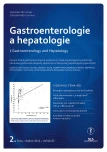Aetiology and pathogenesis of ulcerative colitis. Still more questions than clear answers
Authors:
M. Lukáš 1,2; M. Bortlík 1,3
Authors‘ workplace:
Klinické a výzkumné centrum pro střevní záněty ISCARE Lighthouse a 1. LF UK Praha
1; Ústav klinické biochemie a laboratorní diagnostiky 1. LF UK a VFN Praha
2; Interní klinika 1. LF UK a ÚVN Praha
3
Published in:
Gastroent Hepatol 2011; 65(2): 56-64
Category:
IBD: Review Article
Overview
Despite the fact that the true origin of ulcerative colitis (UC) still remains elusive, basic as well as clinical research bring many new data on ethiopathogenesis of this inflammatory condition. It seems clear that UC originates from interaction of several intrinsic and extrinsic factors that contribute individually in a particular patient. Among internal factors, the gut microbiota, intestinal epithelial cells, and components of gut immune system play the key role. Differences in the composition of microbial environment in the gut (dysbiosis) have been described in patients with UC. Though the genome-wide association studies revealed many new susceptibility loci in UC patients, genetic testing has still no place in the routine clinical practice. Some environmental factors may contribute to disease susceptibility, some others are associated with the risk of acute relapse in UC patients in remission. The former group include nutrients (saturated fatty acids), smoking and appendectomy in past. The risk of acute relapse increases with psychological stress, using some drugs (i.e. non-steroidal anti-inflammatory drugs) and intercurrent infections, especially in upper respiratory tract. The currently accepted model of the pathogenesis of UC is of an inappropriate immune response to host microorganisms in genetically susceptible people. The „hygiene“ hypothesis explains the UC as a consequence of insuficient oral immunotolerance due to minimal antigenic stimulation in early childhood. According to Maratka´s „two-component“ hypothesis, the primary non-specific inflammation may be superimposed by secondary „infection“ originating from luminal bacteria which eventually leads to typical picture of UC.
Key words:
ulcerative colitis – aetiology – pathogenesis – intestinal microbionta
Sources
1. Lakatos L, Lakatos LP. Is the incidence and prevalence of inflammatory bowel diseases increasing in Eastern Europe? World J Gastroenterol 2006; 12(38): 6102–6108.
2. Burisch J, Cukovic-Cavka S, Kaimakliotis I et al. Construction and validation of a web-based epidemiological database for inflammatory bowel diseases in Europe An EpiCom study. Journal Crohn´s Colitis 2011; doi:10.1016/j.crohns.2011.02.016
3. Wilks S. The morbid appearance of the intestine of Miss Banks. Med Times Gazette 1859; 2: 264–269.
4. Swidsinski A, Ladhoff A, Pernthaler A et al. Mucosal flora in inflammatory bowel disease. Gastroenterology 2003; 124(Suppl 1): S1370.
5. Marteau P, Lepage P, Mangin I et al. Review article: gut flora and inflammatory bowel disease. Aliment Pharmacol Ther 2004; 20(Suppl 4): S18–S23.
6. Tamboli CP, Neut C, Desreumax P et al. Dysbiosis in inflammatory bowel disease. Gut 2004; 53(1): 531–534.
7. Fava F, Danese S. Intestinal microbiota in IBD: Friend of foe? World J Gastroenterol 2011; 17(5): 557–566.
8. Pitcher MC, Beatty ER, Cummings JH. The contribution of sulphate reducing bacteria and 5-ASA to faecal sulphide in patients with ulcerative colitis. Gut 2000; 46(1): 64–72.
9. Cairo E. Toll-like receptors in inflammatory bowel diseases. Inflamm Bowel Dis2010; 16(9): 1583–1597.
10. Wekhmap J, Stange E. Paneht´s disease. Journal Crohn´s Colitis 2010; 4(5): 523–531.
11. Vermeire S, Rutgeerts P, Van Steen K et al. Genome wide scan in a Flemish inflammatory bowel disease population: support for the IBD4 locus, population heterogeneity, and epistatis. Gut 2004; 53(7): 980–986.
12. Borm MEA, Van Bodegraven AA, Mulder CJJ et al. A NFKB1 promoter polymorphism is involved in susceptibility to ulcerative colitis. Int J Immunogenet 2005; 32(6): 401–405.
13. Franchimont D, Vermeire S, El Housni H et al. Deficient host-bacteria interactions in inflammatory bowel disease? The toll-like receptors (TLR)-4 Asp299gly polymorphism is associated with Crohn‘s disease and ulcerative colitis. Gut 2004; 53(7): 987–992.
14. Thompson AI, Lees CW, Genetics of UC. Inflammm Bowel Dis 2011; 17(3): 831–848.
15. Mittermaier C, Dejaco C, Waldhoer T et al. Impact of depressive mood on relapse in patients with inflammatory bowel disease: a prospective 18-month follow-up study. Psychosom Med 2004; 66(1): 79–84.
16. Bitton A, Sewitch MJ, Peppercorn MA et al. Psychosocial determinants of relapse in ulcerative colitis: a longitudinal study. Am J Gastroentrol 2003; 98(10): 2203–2208.
17. Tilg H, Kaser A. Diet and relapsing ulcerative colitis: take off the meat? Gut 2004; 53(10): 1399–1401.
18. Maratka Z, Wagner V. The treatment of non-specific ulcerative colitis by autogenous vaccine. Correlated bacteriological and immunological studies. Gastroenterology 1948. 1134–1149.
19. Maratka Z, Spellberg MA. Observations on the clinical course of nonspecific ulcerative colitis. Gastroenterology 1949. 1279–86.
20. Maratka Z, Nedbal J, Kocianova J et al. Incidence of colorectal cancer in proctocolitis: a retrospective study of 959 cases over 40 years. Gut 1985; 26(1): 43–49.
21. Maratka Z. Colitis ulcerosa. Praha: Unie 1948.
22. Maratka Z. Pathogenesis and aetiology of inflammatory bowel disease. In: DeDombal FT, Myren J, Bouchier IAD, Watkinson G, eds. Inflammatory bowel disease. Oxford: Oxford University Press, 1986 (1st ed.), 1993 (2nd ed.).
23. Maratka Z. The role of intestinal bacteria in the pathogenesis of inflammatory bowel diseases. A two-component hypothesis. Folia Gastroenterol Hepatol 2003; 1: 6–11.
24. Rogler G. Update in inflammatory bowel disease pathogenesis. Curr Opin Gastroenterol 20(4): 311–317.
25. Rook GAW, Brunet LR. Chronic inflammatory disorders, the gut and “Old Friends” hypothesis. In: Colombel JF, Scholmerich J, Vucelic B, eds. Inflammatory bowel disease: translation from basic research to clinical practice. Falk Symposium Vol 140. Berlin: Springer, 2005: 43–58.
Labels
Paediatric gastroenterology Gastroenterology and hepatology SurgeryArticle was published in
Gastroenterology and Hepatology

2011 Issue 2
Most read in this issue
- Obtaining biopsies during endoscopic investigation of the gastrointestinal tract for selected inflammatory disorders
- Recommended procedure for small bowel examination in patients with Crohn’s disease
- Quantitative testing in colorectal cancer screening – a view of the near future
- Aetiology and pathogenesis of ulcerative colitis. Still more questions than clear answers
